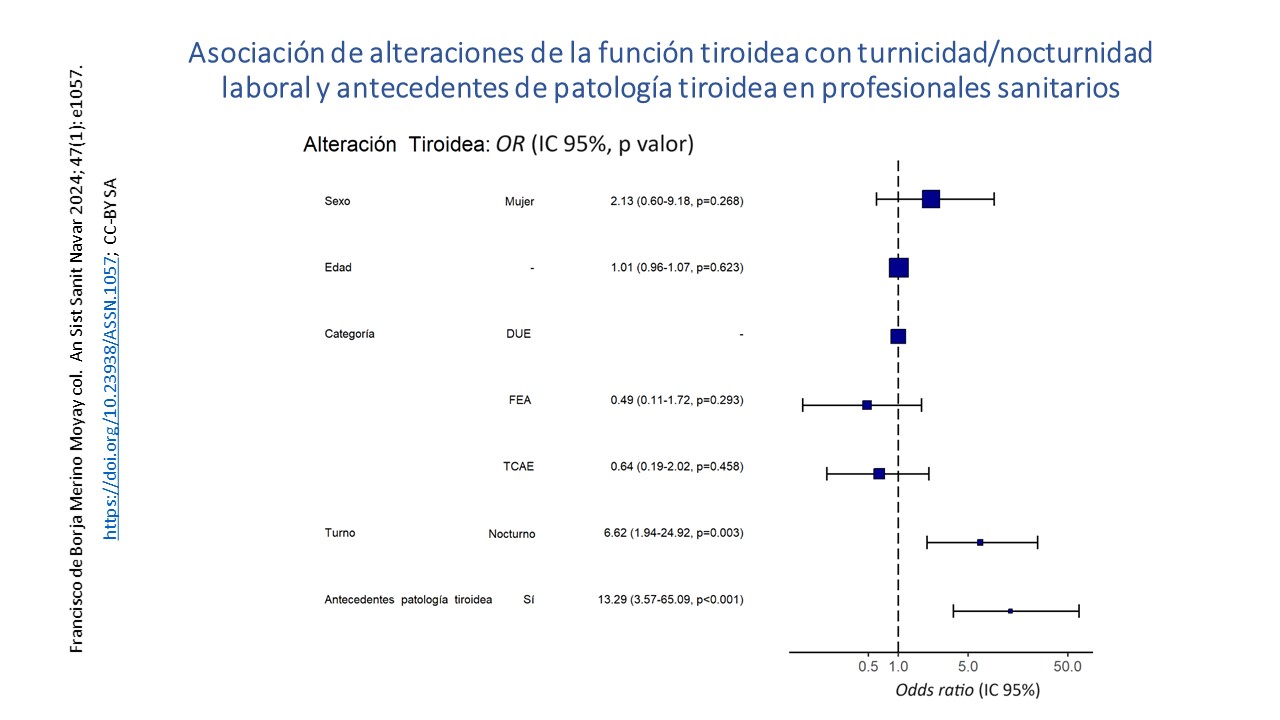Relationship between thyroid function changes with work-/night-shifts and history of thyroid pathology among health personnel
DOI:
https://doi.org/10.23938/ASSN.1057Keywords:
Shift Work Schedule, Thyroid function test, Thyroid Diseases / history, Sex distributionAbstract
Background. The study aim was to analyze the relationship between functional thyroid pathology and the exposure to work shifts / night shifts, and describe the most prevalent thyroid disorders based on the type of shift.
Methodology. Cross-sectional study performed in the emergency department of a hospital in Almeria (Spain). Relationships between thyroxine and thyrotropin levels (TSH) and work shifts, professional category and history of thyroid pathology were analyzed.
Results. The study included 133 workers; 80.5% female, average age was 46.11 years (38 – 65), and 52% were part of the nursing staff; thyroid disorders were more frequent in female participants. Most participants (81.2%) had rotating shifts schedules and 11.3% night shifts (12.1% female and 7.7% male). Thyroid alterations were found in 27% of the participants (usually elevated TSH levels and normal thyroxine levels), particularly in those doing night shifts (61.1%). TSH alterations were more frequent in individuals doing night shifts than in rotating shifts (53.3 vs 13.0%; p<0.001). Individuals working night shifts had mean TSH values in the normal range, although significantly higher than the individuals in the rest of the shifts; thyroxine levels were found to be similar. No thyroid disorders were found in day shift participants. Night shift and a history of thyroid pathology were independent predictors of thyroid disorders.
Conclusions. Night shift schedules and history of thyroid disorders are more frequent in female, both related to the presence of thyroid disorders, indicating the need to include the evaluation of these disorders in health surveillance programs and analyze gender differences.
Downloads
References
GARMENDIA MADARIAGA A, SANTOS PALACIOS S, GUILLÉN-GRIMA F, GALOFRÉ JC. The incidence and prevalence of thyroid dysfunction in Europe: a meta-analysis. J Clin Endocrinol Metab 2014; 99: 923-931. https://doi.org/10.1210/jc.2013-2409
VALDÉS S, MALDONADO-ARAQUE C, LAGO-SAMPEDRO A, LILLO J, GARCÍA-FUENTES E, PÉREZ-VALERO V et al. Population-based national prevalence of thyroid dysfunction in Spain and associated factors: Di@bet.es study. Thyroid 2017, 27: 156-166. https://doi.org/10.1089/thy.2016.0353
MALDONADO ARAQUE C. Prevalencia de disfunción tiroidea en la población española. Implicación del hierro en la fisiología tiroidea. Tesis Doctoral. Departamento de Farmacología y Pediatría, Universidad de Málaga, Málaga, 17 de junio de 2017. https://hdl.handle.net/10630/15135
FLIERS E, BOELEN A, VAN TROTSENBURG AS. Central regulation of the hypothalamo-pituitary-thyroid (HPT) axis: focus on clinical aspects. Handb Clin Neurol 2014; 124: 127-138. http://doi.org/10.1016/B978-0-444-59602-4.00009-5
Sociedad Española de Otorrinolaringología y Cirugía de Cabeza y Cuello. Tiroides: Patologías, síntomas, diagnóstico y tratamiento. https://seorl.net/tiroides-sintomas-diagnostico-y-tratamiento/
SANTIAGO-PEÑA LF. Fisiología de la glándula tiroides. Disfunción y parámetros funcionales de laboratorio en patología de tiroides. Revista ORL 2020; 11( 3 ): 253-257. http://doi.org/10.14201/orl.21514
IKEGAMI K, REFETOFF S, VAN CAUTER E, YOSHIMURA T. Interconnection between circadian clocks and thyroid function. Nat Rev Endocrinol 2019; 15(10): 590-600. http://doi.org/10.1038/s41574-019-0237-z
LESO V, VETRANI I, SICIGNANO A, ROMANO R, IAVICOLI I. The impact of shift- work and night shift-work on thyroid: a systematic review. Int J Environ Res Public Health 2020; 17: 1527. https://doi.org/10.3390%2Fijerph17051527
COPINSCHI G, TUREK FW, VAN CAUTER E. Endocrine rhythms, the sleep-wake cycle, and biological clocks. En: Larry Jameson J, De Groot LJ (eds). Endocrinology: Adult and Pediatric. Elsevier 2016; 147–173.e9. http://doi.org/10.1016/B978-0-323-18907-1.00009-3
MOON SH, LEE BJ, KIM SJ, KIM HC. Relationship between thyroid stimulating hormone and night shift work. Ann Occup Environ Med 2016; 28: 53. https://doi.org/10.1186%2Fs40557-016-0141-0
BUXTON OM, CAIN SW, O'CONNOR SP, PORTER JH, DUFFY JF, WANG W et al. Adverse metabolic consequences in humans of prolonged sleep restriction combined with circadian disruption. Sci Transl Med 2012; 4(129): 129ra43. https://doi.org/10.1126/scitranslmed.3003200
CHANG YS, CHEN HL, HSU CY, SU SF, LIU CK, HSU C. Nurses working on fast rotating shifts overestimate cognitive function and the capacity of maintaining wakefulness during the daytime after a rotating shift. Sleep Med 2013; 14(7): 605-613. http://doi.org/10.1016/j.sleep.2013.03.011
WRIGHT KP JR, BOGAN RK, WYATT JK. Shift work and the assessment and management of shift work disorder (SWD). Sleep Med Rev 2013; 17(1): 41-54. https://doi.org/10.1016/j.smrv.2012.02.002
HARBECK B, SUEFKE S, HAAS CS, LEHNERT H, KROPP P, MOENIG H. No stress after 24-hour on-call shifts? J Occup Health 2015; 57(5): 438-437. https://doi.org/10.1539/joh.14-0276-oa
BURDELAK W, BUKOWSKA A, KRYSICKA J, PEPŁOŃSKA B. Night work and health status of nurses and midwives. Cross-sectional study. Med Pr 2012; 63(5): 517-529.
SPIEGEL K, LEPROULT R, VAN CAUTER E. Impact of sleep debt on metabolic and endocrine function. Lancet 1999; 354(9188): 1435-1439. https://doi.org/10.1016/s0140-6736(99)01376-8
LÓPEZ EM, OSUNA LMS, VARGAS JMG, HURTADO RJ, ROMERO LGL. Características epidemiológicas del hipotiroidismo en un área del sur de España (Sevilla). Rev Clin Med Fam 2020, 13(2): 123-130. https://revclinmedfam.com/displayfile/Article/path_pdf/613

Downloads
Published
How to Cite
Issue
Section
License

This work is licensed under a Creative Commons Attribution-ShareAlike 4.0 International License.
La revista Anales del Sistema Sanitario de Navarra es publicada por el Departamento de Salud del Gobierno de Navarra (España), quien conserva los derechos patrimoniales (copyright ) sobre el artículo publicado y favorece y permite la difusión del mismo bajo licencia Creative Commons Reconocimiento-CompartirIgual 4.0 Internacional (CC BY-SA 4.0). Esta licencia permite copiar, usar, difundir, transmitir y exponer públicamente el artículo, siempre que siempre que se cite la autoría y la publicación inicial en Anales del Sistema Sanitario de Navarra, y se distinga la existencia de esta licencia de uso.







